Introduction: 3 Ways to Make Table Lamps
Making your own table lamp provides a great opportunity to add some very personal, artistic -- and super functional --style to the rooms you spend the most time in.
In this instructable, I show you how to make 3 different styles of table lamps:

Choice #1 - Bottle Table Lamp
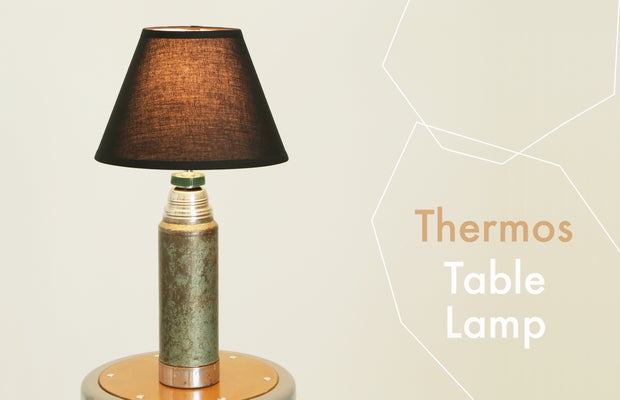
Choice #2 - Thermos Table Lamp

Choice #3 - Mug Stack Table Lamp
Each lamp demonstrates a different way to construct a base, so have a look through their instructions to see which one you may already have a base for, or which one you want to gather the goods for.
Step 1: Safe Wiring Info

I highly recommend that you take (or at least read through) my free Instructables Lamps Class before you make any one of these lamps. In this instructable, I will be showing you how to construct the lamps, but not how to wire them. In my Lamps Class, I go over:
- Electrical safety
- The different kinds of available lamp cord and their best uses
- How to tell which wire is HOT and which is NEUTRAL
- How to safely wire up sockets, plugs, and switches
- How to test your connections before plugging in
Step 2: Table Lamp Base Anatomy
LEFT: Glass Table Lamp - a base w/ no cap, a flat bottom, and non-drillable walls (The Tripod Floor Lamp has similar hardware requirements.)
MIDDLE: Thermos Lamp - a hollow base w/ it's own removable cap, a flat bottom, and drill-able walls
RIGHT: Mug Stack Lamp - sturdy hollow parts stacked on an official lamp base w/ pre-drilled holes that accommodates the cord and a connecting center threaded rod.
The three table lamp projects in this lesson illustrate the three most common types of bases and their assembly structures. The parts used and how they're put together is dictated by the characteristics of each base.
The above illustrations show the different types of table lamp bases, where the cord exits the hardware or base, and where the force is created by the connecting hardware.
Step 3: Bottle Lamp
Choice #1: Shows how to lamp-ify a base w/ no cap, a flat bottom, and non-drillable walls*.
Of the 3 lamp options to choose from in this lesson, this is the easiest to put together.
Glass bottle table lamps are a very classic look and always remind me of New England. They fit in many different styles of decor because of how neutral they are -- and can rely on the shade choice to direct its style.
*You can actually drill a 'cord out' hole in glass bottles, I just want to show you how to wire a base that isn't possible to drill into without risk of breaking, like pottery. You may also not have the tools you need to make a hole, or just wish to leave them intact!


Here's the parts you need to make this sweet and simple lamp:
NOTE: all parts are to fit 1/8 IP threaded rod
- (x1 - $0-$5) glass bottle that's at least 9" tall and has either a wide (= more stable) or weighted bottom (= thicker glass)
- (x1 - $10.99) bottle lamp kit*
- (x1 - $0.35) 1 1/2" stamped nickel plated neck
- (x1 - $0.20) 1 1/4" nickel plated check ring for 1/8 IP**
- (x1 - $0.35) 3" 1/8 IP threaded nipple
- (x2 - $0.03 each) nickel plated lock washers
- (x2 - $0.22 each) nickel knurl nuts
- (x2 - $0.08 each) 3/4" steel washers
- (x1 - $0.04) steel nut for 1/8 IP
- (x1- $0.48) 1" rubber adapter
- (x1- $1.25) short bulb clip
- (x1- $1.25) long bulb clip
Approximate parts cost (before taxes & shipping): $20.57
I recommend finding your bottle first and then ordering the parts so you can measure the diameter of the bottle neck and make sure you'll have a check ring that's the right size.
*I like ordering the kit because it's cheaper than buying some of the parts we need individually. We still need to supplement it with a few parts, as I have my own way of making bottle lamps that is different from the kit instructions. I think my way is more stable and uses better looking visible hardware. :)
**Measure the diameter of the top of your bottle neck to find your check ring size.
NOTE: I never add harps to smaller lamps because I find there's more flexibility in shade choices, as about 50% of the smaller shades come with a built-in bulb clip instead of a spider/washer. I go over what this means in more detail later in the next lesson, Lampshades: Supporting Hardware & How to Choose Them.
Tools you'll need to make this lamp:
Step 4: Bottle Lamp: Assembling the Hardware
The first thing we need to do is make sure that the rubber adaptor fits inside the opening of the bottle neck. This is the part that is going to anchor the lamp bits to the bottle, so it needs to fit snuggly.

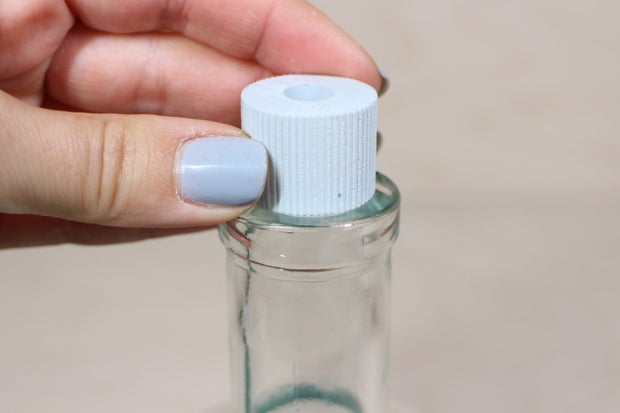
Because there are so many different inside diameters of bottle necks, it's not likely that one from the kit will fit without needing to be adjusted. As you can see above, the best choice is one that's bigger than needed as it's possible to remove material, but impossible to add it. :)




Place the rubber adapter on a cutting mat and use the box cutter to carefully cut off thin strips all the way around. Test it on the bottle.

Keep repeating this process until it JUST fits inside. It should be big enough to still require a bit of effort/twisting to get it half way in.
Stop at half way otherwise you'll have a hard time getting it out again! Remove it from the bottle and set it aside.


Screw one of the knurl nuts onto the nipple so that it's flush with the bottom. Then slide on a lock washer first, followed by a regular washer.


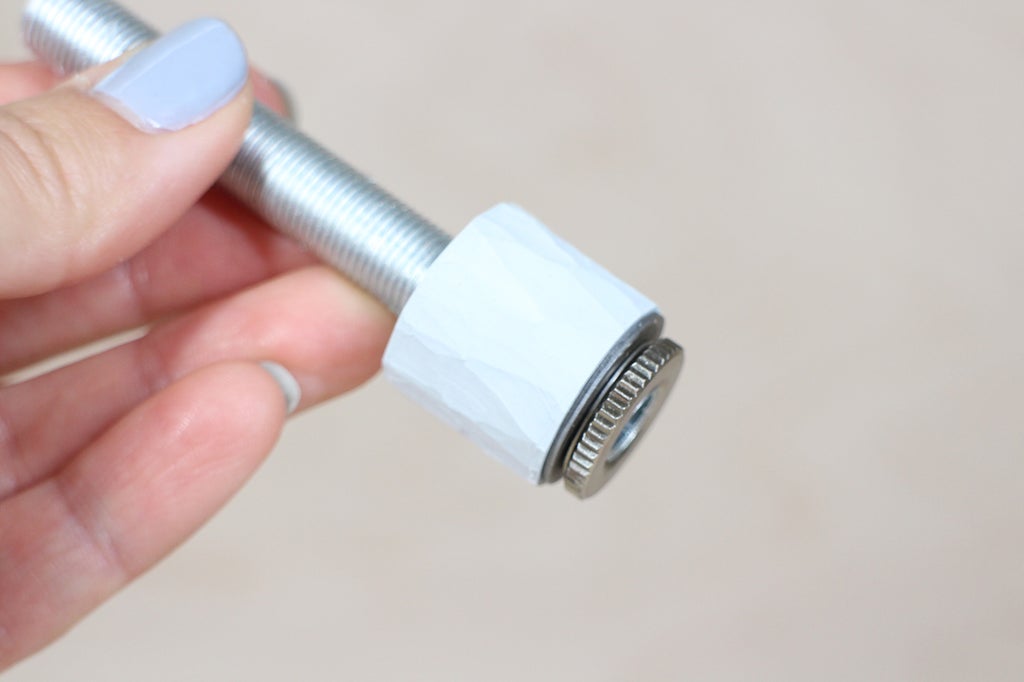
Next, slide the rubber adapter onto the nipple and squish it down using both hands until it's snuggled up next to the washer.



Place the rubber adapter back into the bottle, nuts and washers down, and squish it into the neck until the top of the adapter is just slightly lower than the bottle top. (like pictured above)
Do this by pushing the adapter and not the nipple, to ensure that the washer and nut are still snug up against the bottom of the adapter.



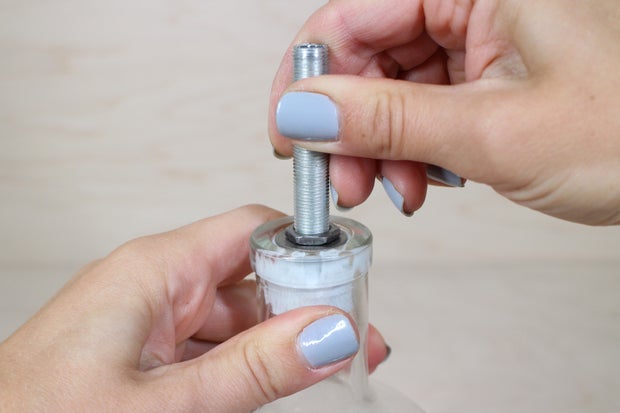
Now that you have the adapter in place, slide on a regular washer and nut. Use the small Channellock pliers to tighten the nut.
Keep checking that the nipple is straight up and down and that it hasn't gotten off kilter. Tightening the nut compressed the rubber adapter, which secures it in place even more.
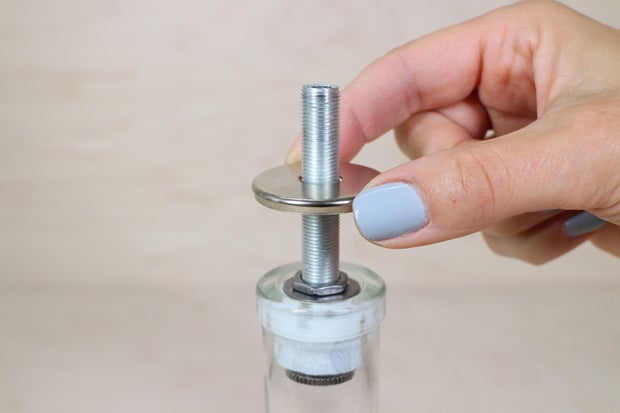

Slide the check ring on next.


Next, slide on the neck and screw on a knurl nut, making sure the neck bottom is centered on the check ring.


Add the last lock washer.

Now for the final piece to be screwed on! The socket cap. This is the defining piece for this type of lamp. The side outlet for the cord allows for adding lamp parts to bases that would be challenging or impossible to drill through and/or into.


Screw on the cap and tighten the side screw if there is one. (Not all caps have one.)
And that's it for the hardware!! Now we're ready to wire it up.
Step 5: Bottle Lamp: Wiring the Socket


Feed the stripped ends of the lamp cord set up through the side hole of the cap. Pull the wires apart about 3" and tie an Underwriter's Knot.
NOTE: To learn how to tie an Underwriter's Knot, refer to Lesson 3 of my Lamps Class.

Wire the socket by connecting Hot/smooth wire to the Hot/brass screw terminal and the Neutral/ribbed wire to the Neutral/silver one. For a complete wiring how-to, visit Lesson 3 of my Lamps Class.


Snap the socket shell into place.

Test your connections using a continuity tester or multimeter.

Be super proud!! You just made a really sweet table lamp!! In the next lesson, I'll talk about how to pick the perfect lamp shade for your lamp.
Step 6: Thermos Lamp
Choice #2: Shows how to lamp-ify a hollow base w/ it's own removable cap, a flat bottom, and drill-able walls.
If you're like me, I like to keep objects around me that either remind me of positive memories from my past or represent things I love to do in the present. This vintage thermos table lamp manages to do both for me! I grew up going to a summer cabin and camping and have wonderful memories from those times AND I also still love to camp and be outdoors, so this lamp does a perfect job of representing my past and present. :)
Of the 3 lamp options in this lesson, this one is my personal favorite and also the most challenging. I'll confess that I didn't think it would be, until I went to drill a hole in the side towards the bottom -- for the lamp cord to come out of -- and discovered that Stanley insulates their thermoses with powdered charcoal!
Once I figured out what was going on, as little clouds of grey puffed out while I drilled, I was able to solve the problem pretty easily, but it did add an extra couple steps and some time, so just fair warning, this one has a twist!
If you choose a different brand of thermos, it may not have the same surprise (aka no insulation, just air, which is what I was expecting on mine) or it might have its own, in the form of a glass interior that you need to break and remove in order to get the cord through. But I think the result is worth invoking the spirit of MacGyver and trouble shooting what comes, because thermoses are so good as lamp bases!
P.S. If you love this lamp, but don't want to deal with the wee mess, you can always use a socket cap with a side out hole like the Bottle Lamp. The rest of the hardware and assembly would be exactly the same. You'd just skip the hole drilling and adding a bushing part.
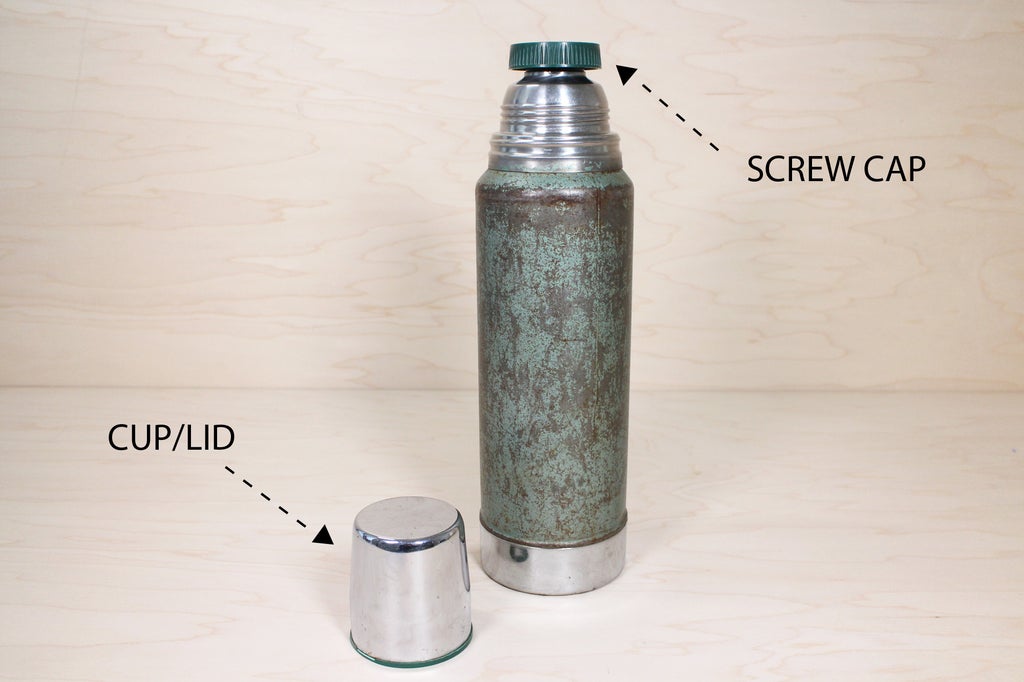
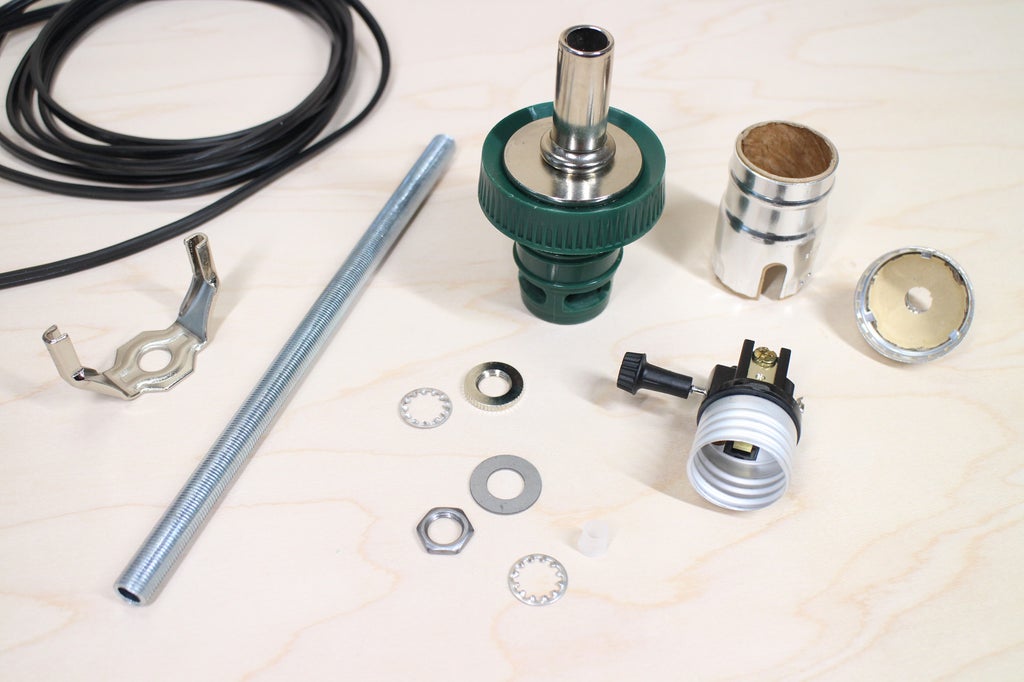
L to R: cord, saddle, threaded nipple, lock washer, nut, knurl nut, washer, check ring & neck (on screw cap), bushing, socket
If you choose to take on the fun challenge and proceed with this one, here's the parts you'll need:
NOTE: all parts are to fit 1/8 IP threaded rod
- (x1 - $0-$10) vintage thermos*
- (x1 - $0.30 p/foot) 8' of black 18/2, SPT-1 lamp/zip cord
- (x1 - $2.50) nickel metal cap and shell on/off socket
- (x1 - $0.65) black Kwik polarized plug (not pictured above)
- (x1 - $1.50) 6 1/2" nickel harp and saddle
- (x1 - $1.00) 6 - 8" threaded nipple (Depends on the height of your thermos. I used 8".)
- (x1 - $0.35) 1 1/2" stamped nickel plated neck
- (x1 - $0.21) 1 5/8" nickel plated check ring
- (x2 - $0.08 ea) 3/4" steel washer
- (x2 - $0.03 ea) lock washers
- (x1 - $0.22) nickel knurl nut
- (x1 -$0.04) steel nut
- (x1 - $0.05) plastic internal pipe hole bushing
- (x1 - $0.60) metal bushing (not pictured above)
- (x1 - $1.44) self-adhesive felt (not from Grand Brass)
*Any size or brand will work, as long as it has it's screw on cap or cup/lid. I chose to use the screw cap and not the lid, but the lid would also work and would require the same parts)
Approximate parts cost (before taxes & shipping): $18.68
And the tools you'll need are:
- Manual OR automatic wire stripper
- Small wire cutters
- Box cutter
- 4.5" Channellock pliers
- 6.5" Channellock pliers
- Small flat head screwdriver
- Phillips head screwdriver
- Needle nose pliers
- Continuity testerOR multimeter
- Electrical or masking tape
- Measuring tape
- Cutting mat
- Hand drill
- Safety glasses
- Grip mat (I use spongy shelf liner, cork or rubber would also work)
- 2 clamps
- 2 pieces of wood (2x2" or 2x4" by 12")
- Center punch
- Hammer
- 25/64" drill bit
- 3' ball chain
- Self adhesive felt (circles or sheets)
- Step drill bits
- Silicone squeeze tube
- 5 minute epoxy
Step 7: Thermos Lamp: Assembling the Hardware
The first thing we need to do is prep the thermos' screw cap so that it's ready to have all the hardware attached to it. The screw cap serves the same purpose as the rubber adapter did for the Bottle Lamp -- it's securing the lamp hardware to the lamp base. That's why thermoses are ideal, because they come with their own built in adapters!!


Hollow space = room for hardware.

A nice strong bottom that can handle the hardware tightening force.
Remove the screw cap from the thermos.



If there are any ridges or bumps on the top side of the cap, use the box cutter to gently scrape/carve/cut them off. This is important to do so that the check ring can sit flat and the neck will be able to be perfectly straight up and down.

L to R: knurl nut, lock washer, harp saddle, neck, check ring, cap, washer, lock washer, nut, bushing (rod behind)
This is a little pictorial overview of the parts we'll be using and how they'll be added in relation to each other.

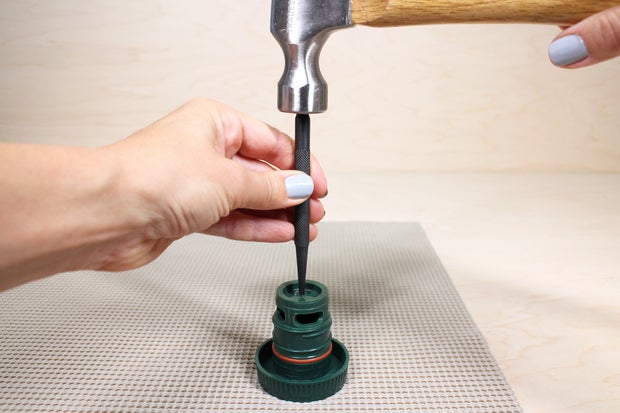
Next, we need to drill a hole through the bottom of the thermos cap that is big enough for the nipple to go through.
If you have a tiny bump like I do on the center point (this will make keeping the drill in place hard), use the small wire cutters to trim it off. Then mark the center with a gentle tap from the center punch.

Secure your 25/64 drill bit into your hand drill.
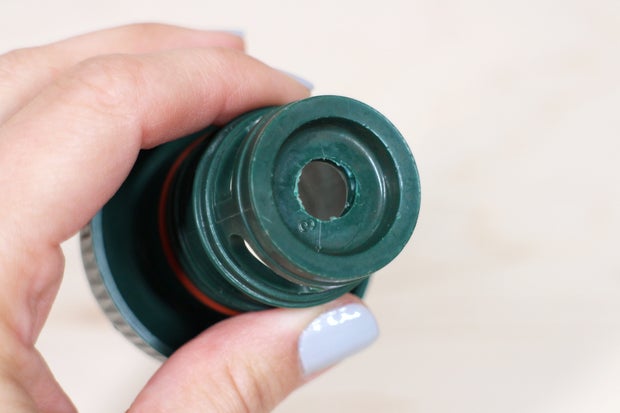
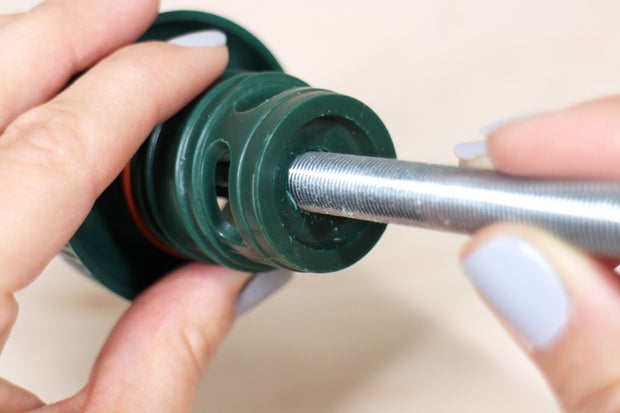
Testing, testing. Check to make sure the nipple fits through the hole easily.

Now it's time to assemble the hardware. This is the order for the top half.
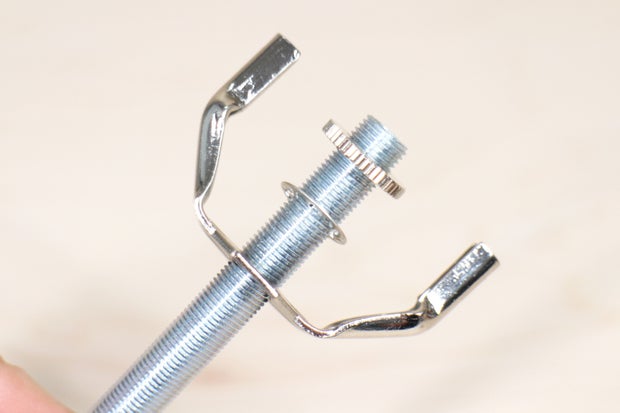

Screw the knurl nut onto one end of the nipple, about 3/8" down. From the other end, slide on a lock washer and then the harp saddle - with the prongs facing the knurl nut. (like pictured) Next, slide on the neck narrow end first and then the check ring.

Slide the nipple into the thermos' cap, wide end first.
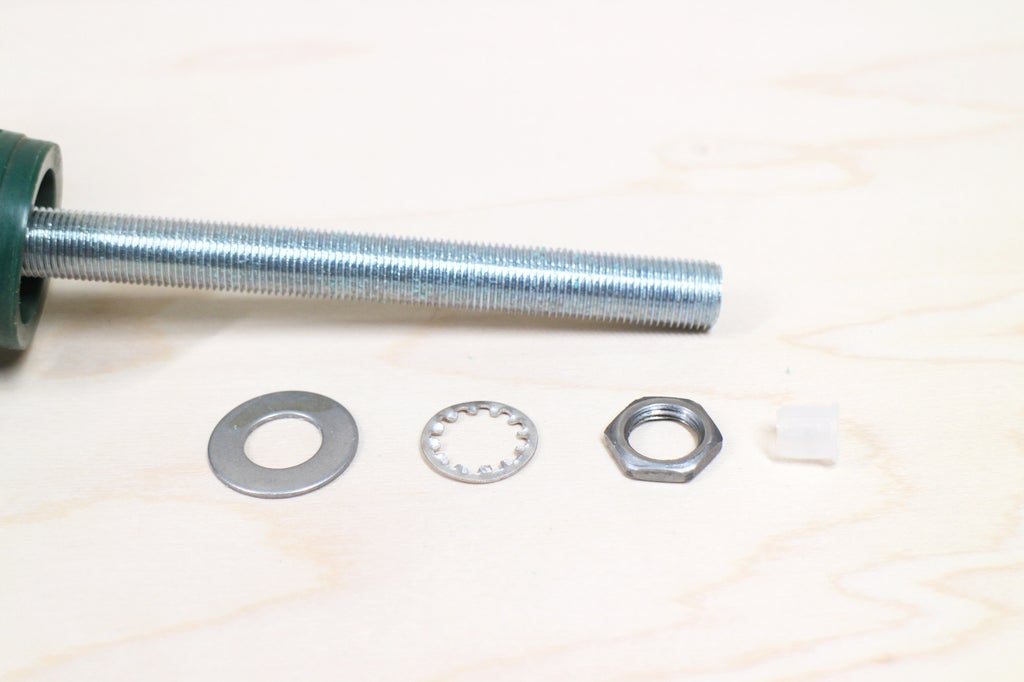
This is the order of the bottom half hardware.

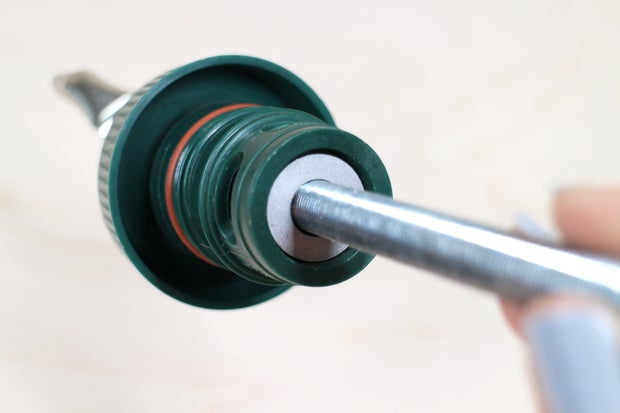
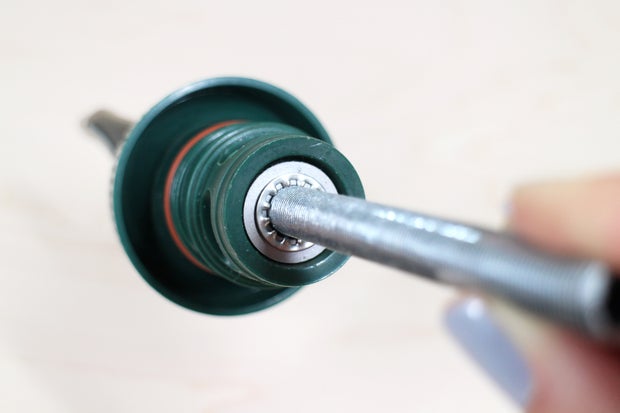


Slide on a washer, followed by a lock washer, and then - as a finishing move - thread on a nut.



Now it's time to tighten everything together into a solid lamp support unit. (Yay!)
Take the bigger Channellock pliers and grab hold of the bottom side nut using your non-dominant hand. With the smaller Channellock pliers and your dominant hand, grab ahold of the top side knurl nut and hold the bottom pliers steady while twisting the knurl nut clockwise. Do this until it's as tight as it will go (without hulking out and breaking the cap.) Give the saddle a little twist to make sure everything is secure.


Next, place the interior rod bushing into the end of the rod. If it isn't a snug fit (this can happen sometimes), you can use a dab of Elmer's glue to keep it in place.
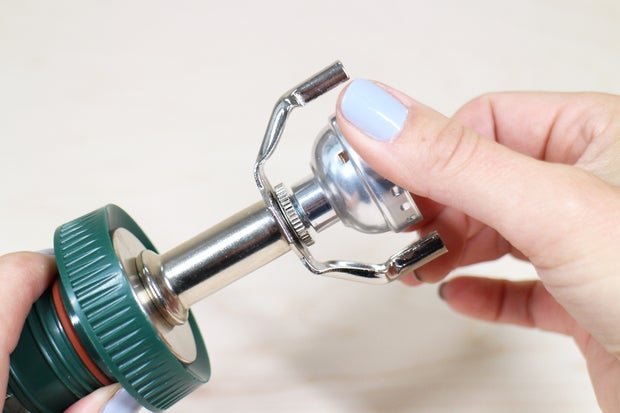

Finally, screw the socket cap onto the top of your new construction and tighten the side screw, if there is one.
Now it's time to add the cord and socket.

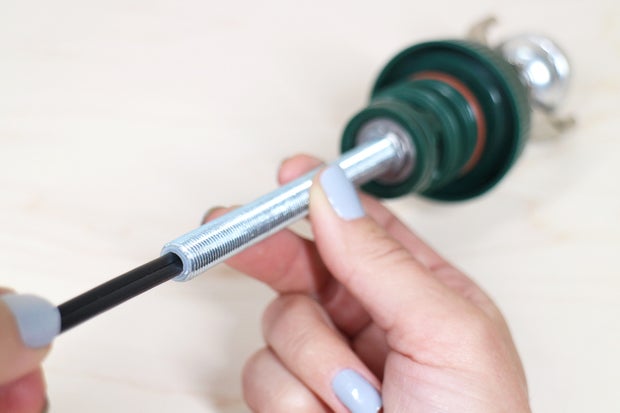

Slide one end of the cord up into the bottom of the nipple and out through the cap. Pull the cord out about 4".

Tie an Underwriter's knot. To learn the steps, visit Lesson 3 of my Lamps Class.

Strip 5/8" insulation off the wire ends. Fan and twist the wires in preparation for bending the 'U' shapes and wiring up the socket.

Aaaand, wire up the socket – like I demonstrate in Lesson 3 of my Lamps Class! Make sure the wires are tidy and not willy nilly.


Pull the cord so that the socket nestles into the cap and slide on the shell, snapping it in place.


Ta da!!
Next up is preparing the thermos lamp base.
Step 8: Thermos Lamp: Prepping the Thermos Lamp Base
In this section, we're going to drill a hole into the side of the thermos, through the inner and outer metal walls. (The inner wall is the stainless steel container that holds the liquid.) In order to achieve this, we will have to deal with the powdered charcoal that fills the space between the two metal walls. So we will first drill a hole in the outer metal, and wash out the charcoal. Once we've rinsed out as much as possible, we'll then drill the hole through the inner metal wall.
I recommend putting cardboard or newsprint down underneath the grip mat and clamp system to keep your surface safe from the charcoal. It's not harmful, but it is sooty/ dirty. I'd also put on some work clothes that you don't mind getting dirty.
RECOMMENDED SAFETY EQUIPMENT: safety glasses and a lightweight respirator mask.
Ok, let's get down to business.
First we're going to measure how far down the inner metal container (that holds the liquid) goes down into the thermos, so we know where we have to drill to go through both walls.

The deep dark depths of my thermos.


Insert a ruler or measuring tape and find out how deep the interior container goes. Mine was 11" deep.

Lay the grip mat down on top of a tarp or newsprint (not pictured, because I didn't discover the charcoal until later...).
Clamp two pieces of wood to your work surface so that they hug the thermos. This will keep the thermos from moving around too much while you drill.


On the outside of the thermos, measure and mark 11" (or whatever measurement your thermos has) down from the top of the thermos.
Place the bushing top side down so that the mark lines up with the outer edge of the bushing. Then scootch the bushing up just a bit to ensure that when we drill, we'll go through both the inner and outer wall and not just skirt the bottom of the inner container. Mark the center of the bushing with a pencil or pen. This is our drill mark.
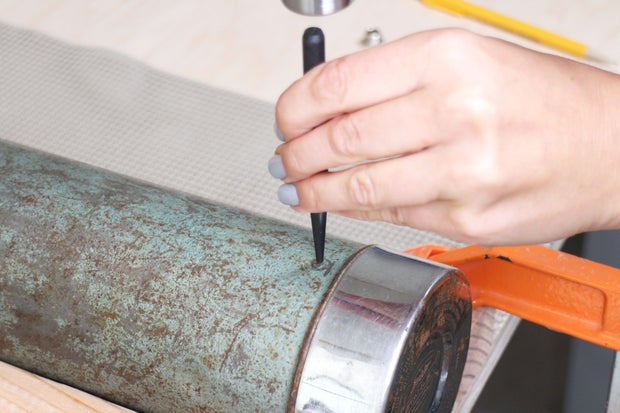
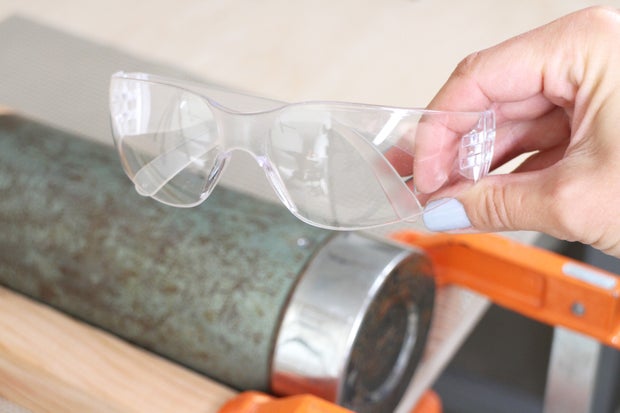
Use a few whack of the hammer to make a center punch mark on your pencil mark. And get ready to drill by putting on your safety glasses and mask.

Secure the step bit in the chuck of your hand drill and carefully drill a hole in the outer metal wall. The charcoal will come out a bit in a small cloud making it hard to see where you're drilling, but stop when you feel the drill come up against the inner metal wall.
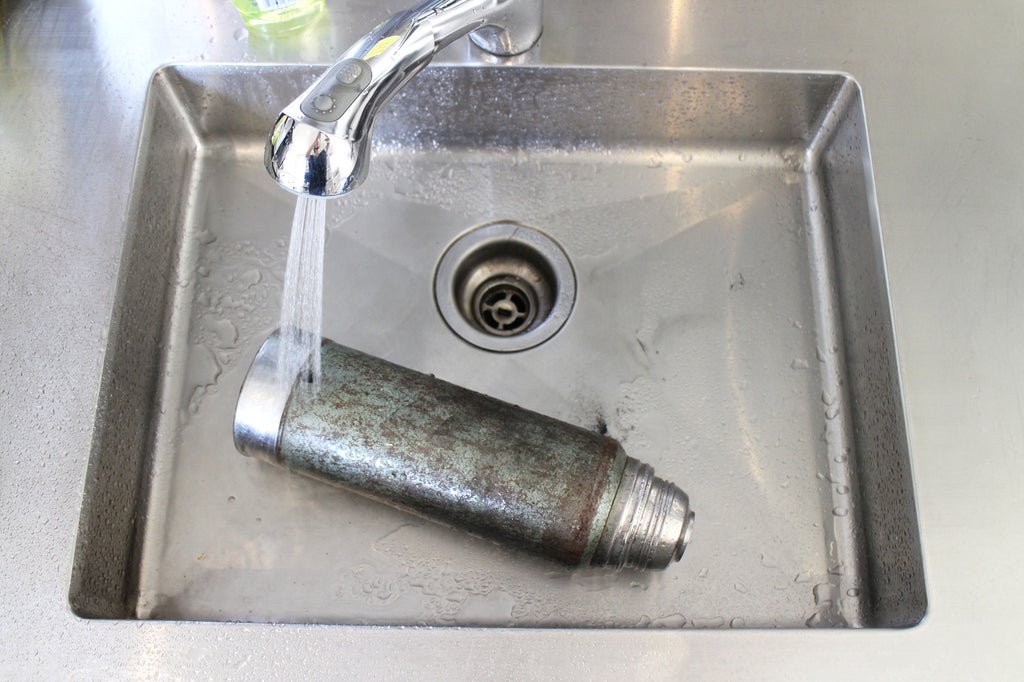

Then take the thermos to a sink and fill > drain, fill > drain, fill > drain - until the water that runs out of the thermos is fairly clear. It doesn't have to be perfectly clear, just no longer black.
Hold the thermos up and drain as much water out of it as possible. Then leave the thermos sitting upright in the sink for a few minutes for good measure.
Wipe the outside dry with a shop towel or some paper towel.
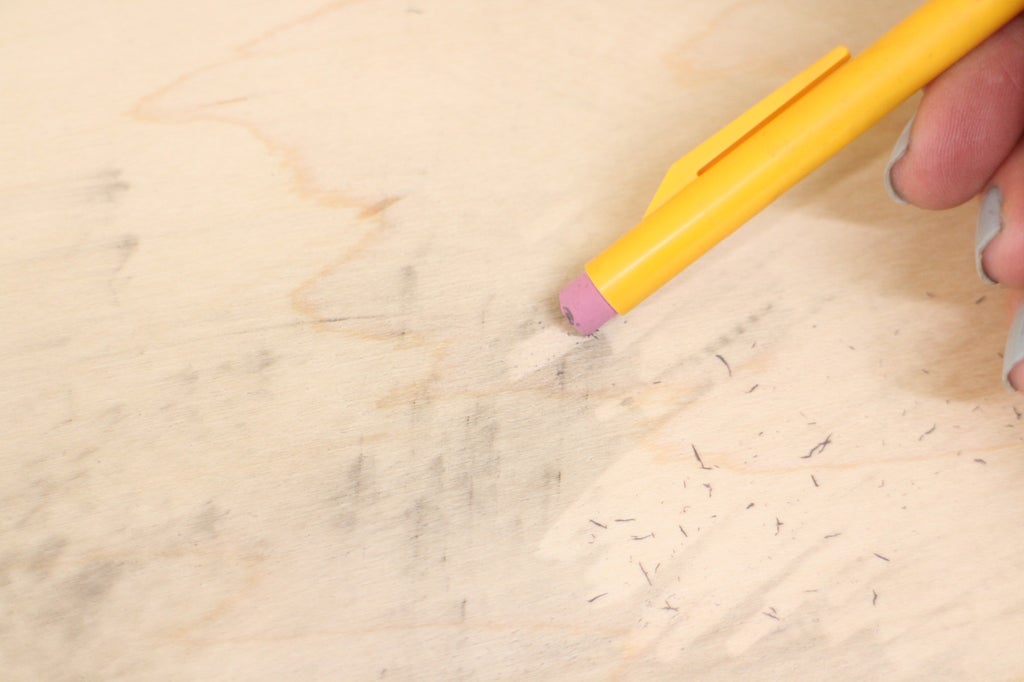
NOTE: If you did get any charcoal on your work surface, a good, soft eraser will remove it.
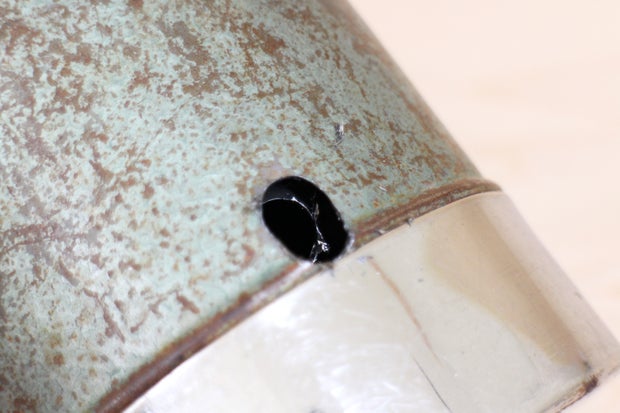

Finish drilling through the second inner metal wall and use the small wire cutters to clip off any sharp metal bits that are still attached.
Now that we've created a way for the cord to exit the thermos, we have to add a bushing to the hole to protect the cord from the sharpness of the metal. I made the hole a little bigger than I wanted to, so I'm adding a washer behind the bushing in order to cover the hole (for aesthetics) and also so that I can glue the bushing in place.

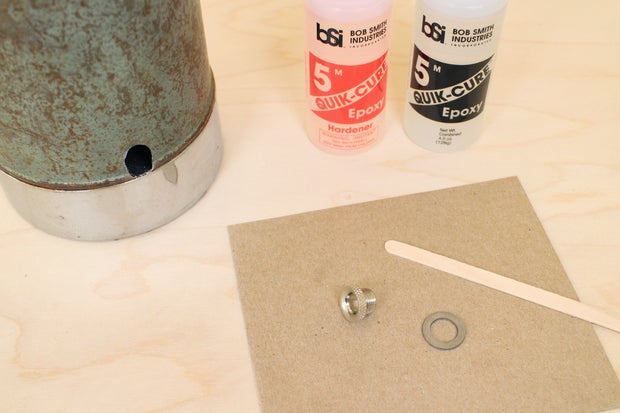



Use 5 minute epoxy (two small equal parts mixed together on a disposable surface) and a nail or craft stick to glue the washer to the back side of the bushing. Let dry.



Mix a fresh, small batch of 5 minute epoxy and use another stick to put glue on the back of the washer/bushing combo.
Lay the thermos down and place the bushing into the drilled hole, taking care to center it so that the washer is covering the hole. Let it dry for 5 minutes.
And ta da! We now have a smooth and safe hole for the cord to exit the thermos/lamp base.
Step 9: Thermos Lamp: Moisture Proofing the Lamp

Because of the unexpected moisture that's now inside the thermos, it's a good idea to seal the bottom hole of the nipple with some silicone. This will keep any evaporating moisture from making its way up to the socket.
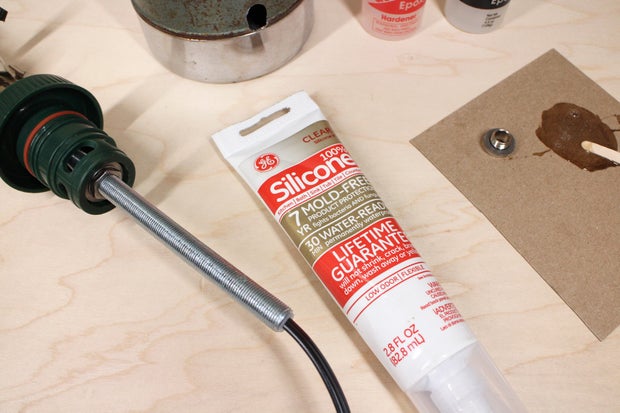
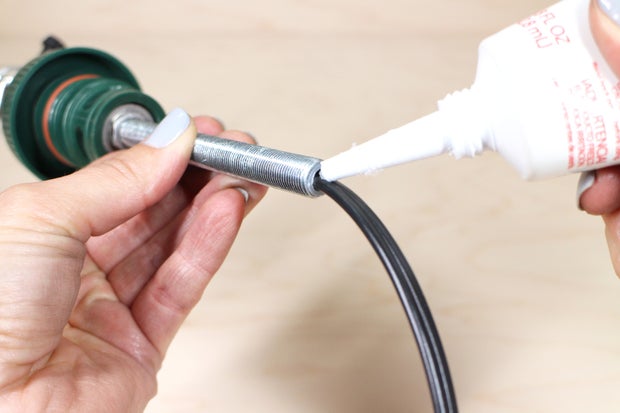



Fill the end of the nipple around the cord with kitchen/bath silicone. Use a craft stick or small piece of cardboard to wipe off the excess silicone.
Set it aside to dry for 30 min.
Step 10: Thermos Lamp: Putting It All Together!
Now that we've prepped the necessary parts, it's time to put them together. (We're almost done!!)
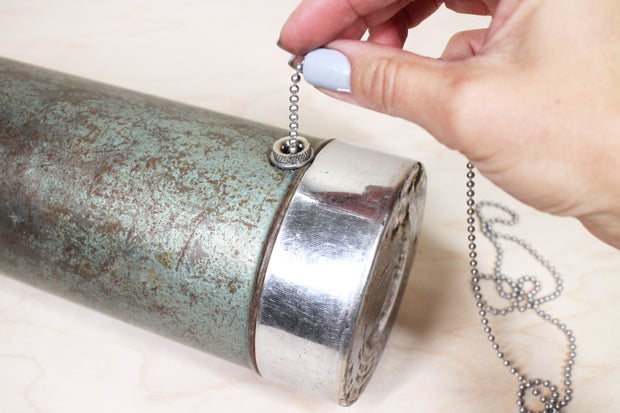
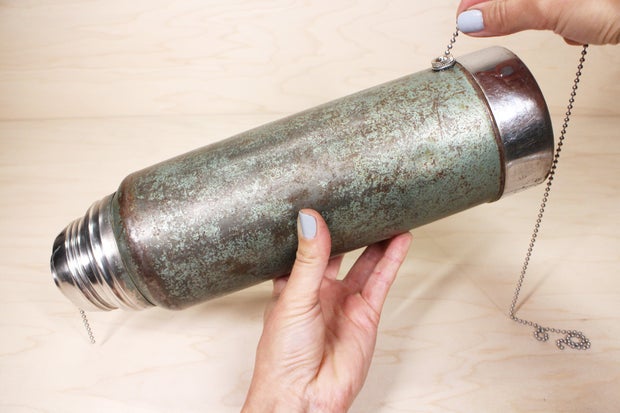
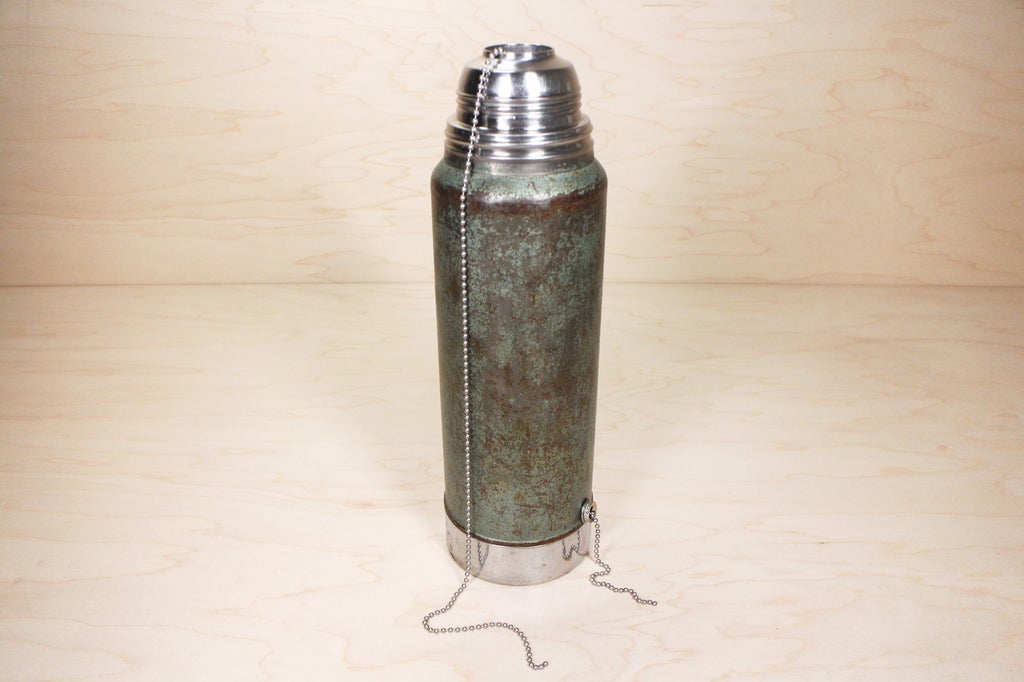
Gently insert the ball chain into the hole we made at the bottom of the thermos - making sure it goes through the inner wall hole as well.
Turn the thermos upside down so that the chain runs through the inside and out the top. (like pictured) Set the thermos down upright, leaving chain coming out of both ends.
We're going to use the chain to pull the cord into the thermos and out the hole. Something that would be VERY challenging to do otherwise.


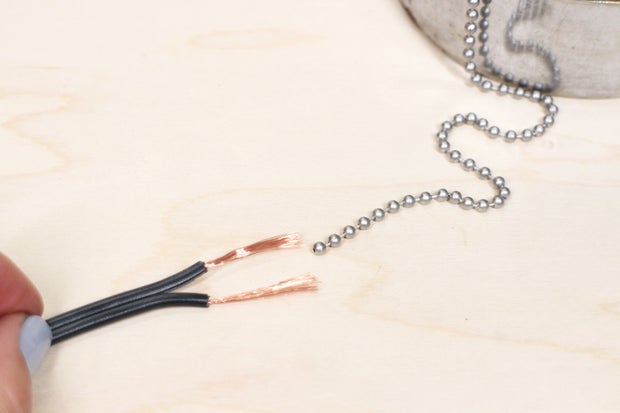
Cut, separate, and strip the wire ends about 1". DO NOT fan and twist the ends. Just leave them as is, wild and free.
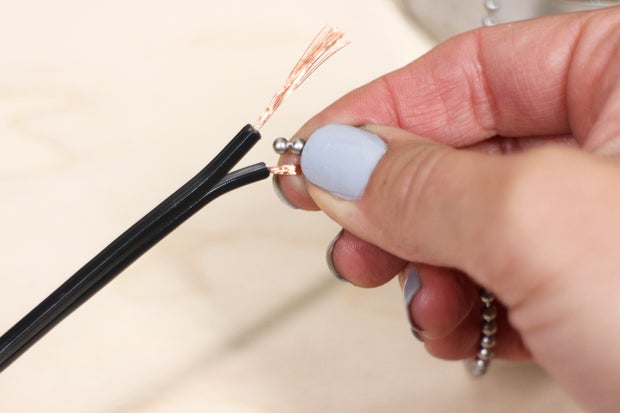
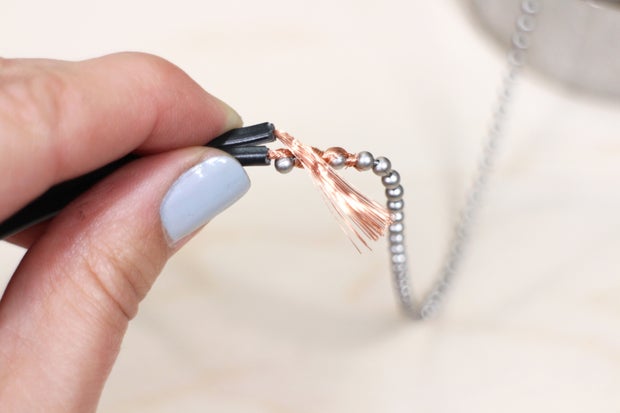
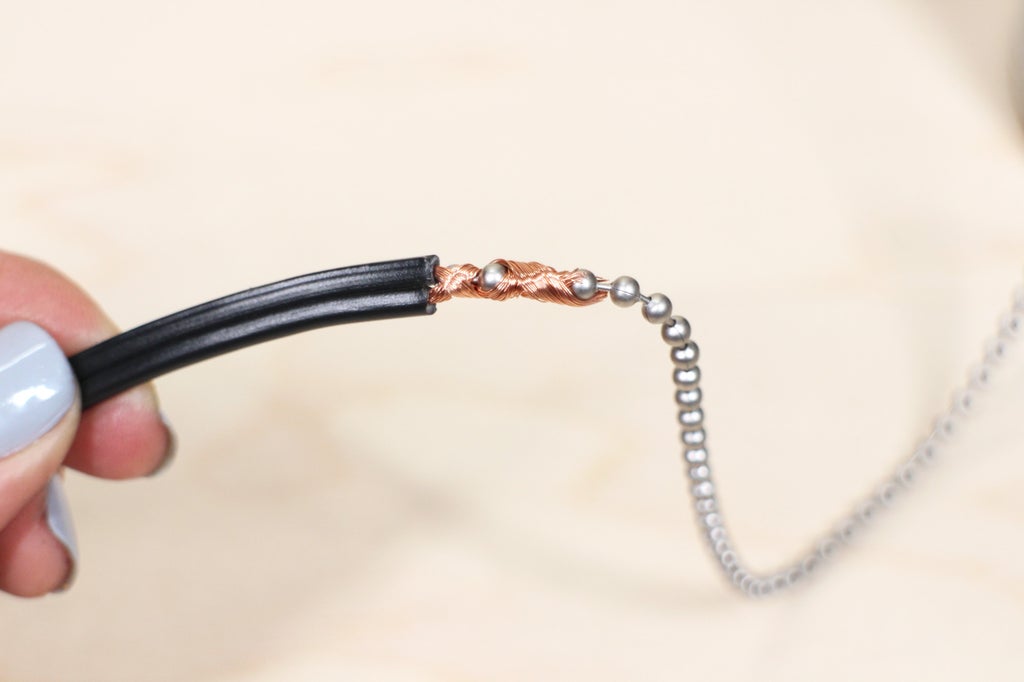
Wrap one side of wire around the end of the ball chain, and then repeat for the other side, like pictured.


Wrap the connection in a piece of electrical tape, being careful to keep the tape thin, by not directly overlapping it on itself, and as flat as possible.

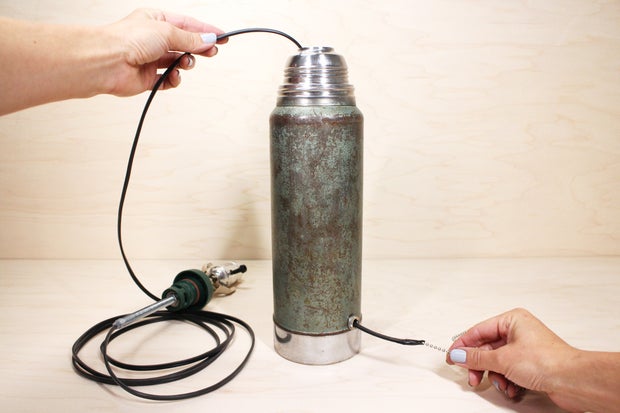

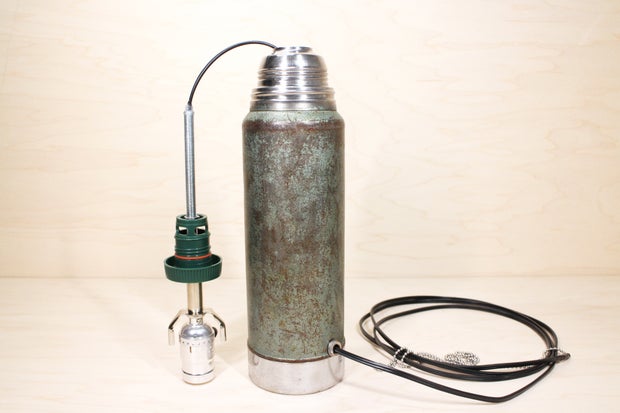
Pull on the bottom of the ball chain with one hand and guide the lamp cord into the top of the thermos with the other. Keep pulling and feeding until the cord is almost all the way through and the nipple reaches the opening of the thermos.

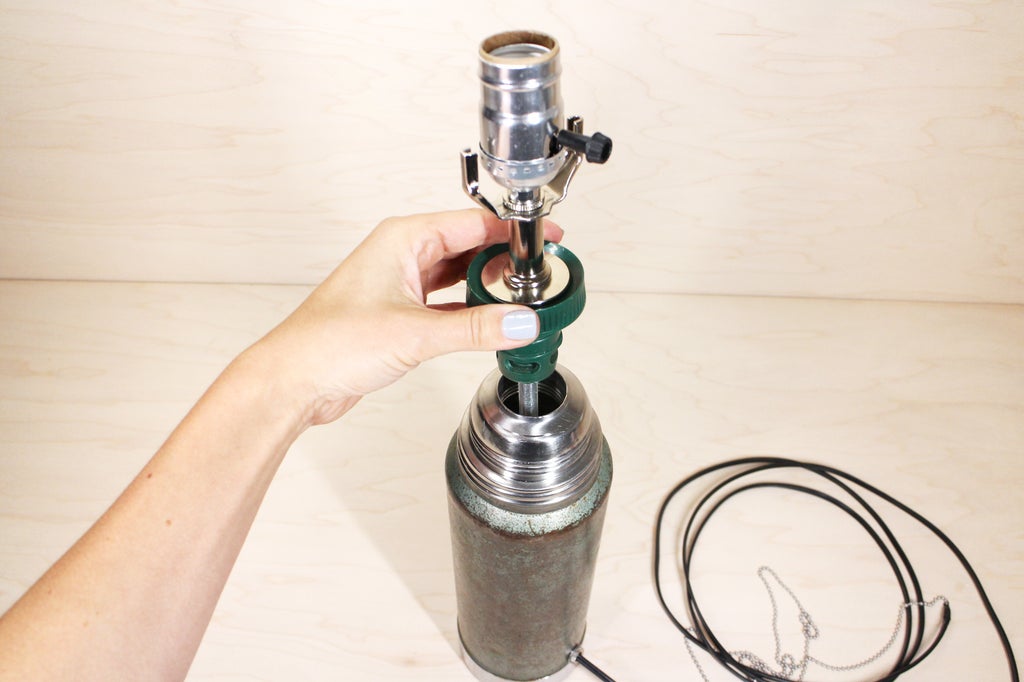
Slide the end of the nipple and the fixture down into the thermos and set the thermos upright onto the table. Spin the fixture + cap counter clockwise 4-5 times and then screw the cap back into place on the thermos.
Now we're going to add the plug!

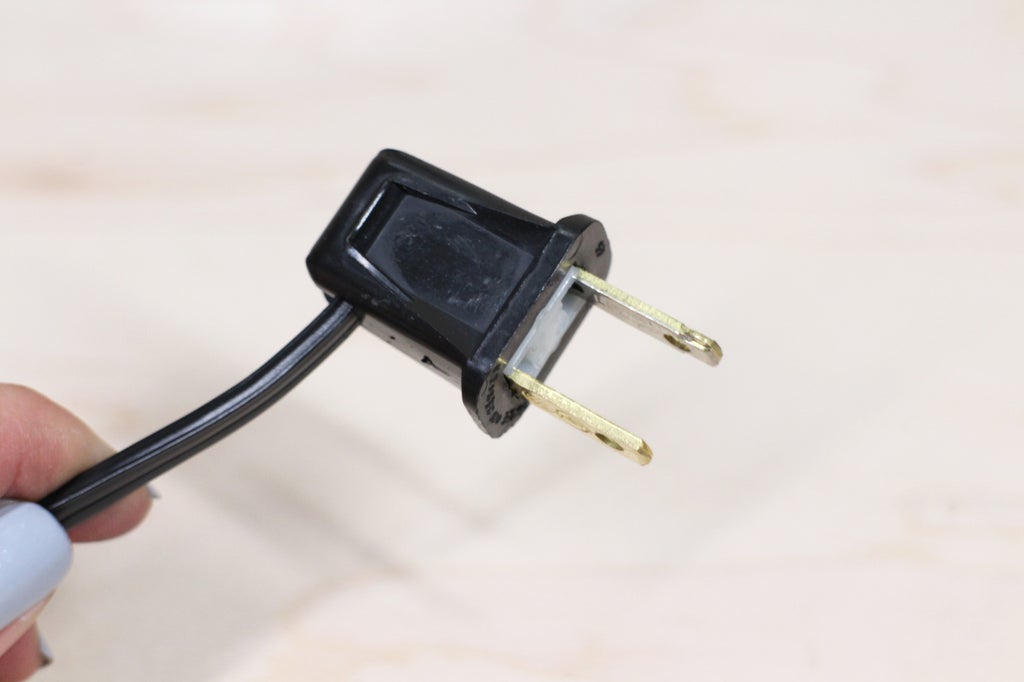
Use the wire cutters to cut off the ball chain/wire/tape connection -- being sure to make a perpendicular cut on the cord for inserting into the Kwik plug.
Add the plug. To learn how to do this correctly, read through Lesson 4 of my Lamps Class.
Adding felt to the bottom of table lamps is always a good idea. Especially if the lamp has a metal base with imperfections in the surface. Those imperfections can harm the table or surface the lamp rests on. Adding felt is a quick, easy, and visually subtle way to solve this problem.
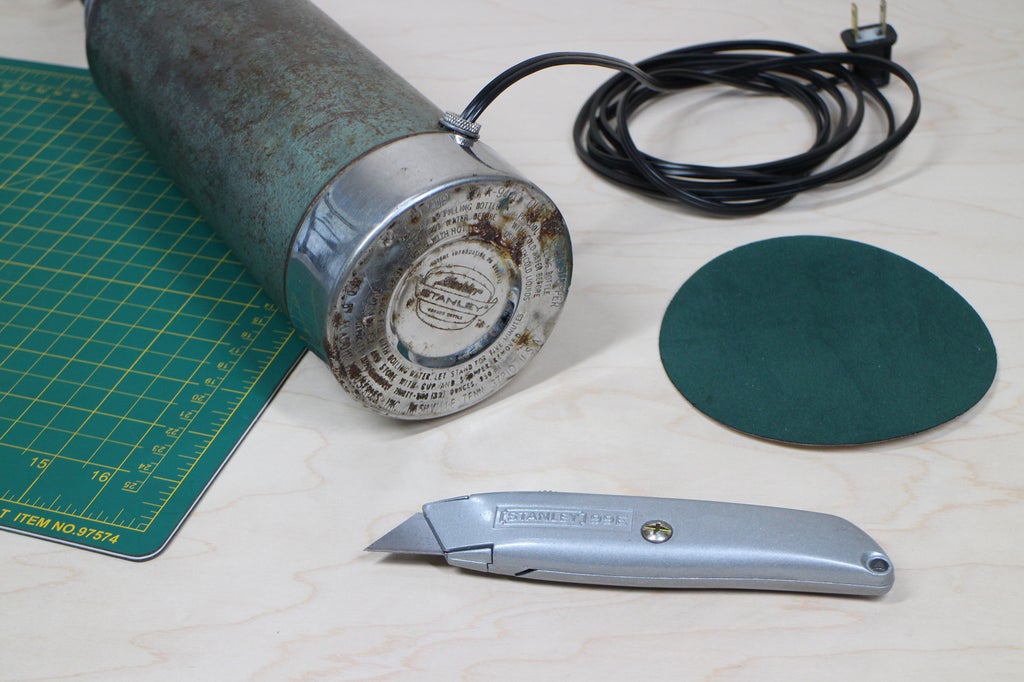
You'll need a cutting mat, your box cutter, and of course, some self-adhesive felt.


The chances of any pre-cut felt circles fitting your 'found object' lamp perfectly is slim. This part usually requires that you customize their fit -- especially true if you're using felt sheets instead of circles. To do this, remove the backing of off the felt adhesive. Place the edge of the lamp base a bit in from the edge of the circle. The goal is to end up with some extra felt all the way around.

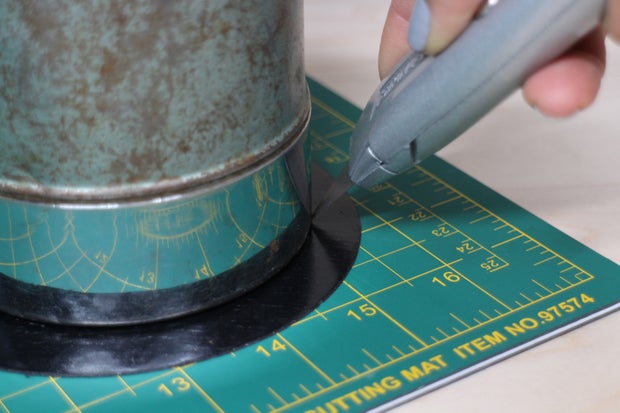
Lay the base all the way down and confirm the 'all around' excess. Make sure the lamp/felt combo is on the cutting mat and cutting at a 45 degree angle, use the box cutter to follow the edge of the lamp, removing the extra felt.

Cutting at an angle ensures that the edge of the felt is just slightly smaller than the diameter of the lamp, so the cut edge isn't visible once the lamp is placed on a surface.

Like so! You can hardly tell it's there and it will take care of all the surfaces your lamp comes in contact with.
TESTING, TESTING!
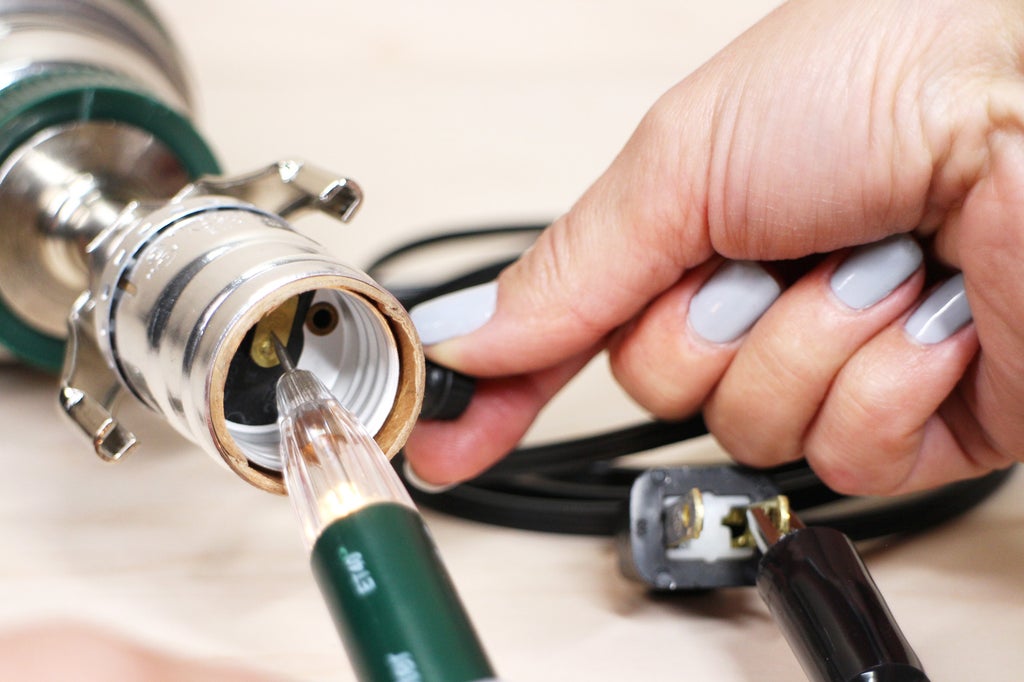
Test your connectionsusing a continuity tester or a multimeter.

Great work on this one. It's such a classic, iconic object that it should hold it's style value for many years to come. There's just one more step before you're done...
Drop the mic.
P.S. In Lesson 9 of my Lamps Class, I go over choosing a lampshade and your options for attaching it.
Step 11: Mug Stack Lamp
Choice #3: Shows how to lamp-ify sturdy hollow parts stacked on an official lamp base w/ pre-drilled cord out & hardware holes that accommodates a connecting center threaded rod.
This lamp is made up of more pieces of my childhood! And it's a great example of a center rod lamp construction. You are welcome to use any hollow object (or combo of stackable objects) that is perfectly flat on the top and bottom, and is open on the top and drill-able on the bottom. If you have any questions about what would or wouldn't work, feel free to send me a message via my Instructables profile page.
Here are the parts you need to make this exact retro lamp:
NOTE: all parts are to fit 1/8 IP threaded rod
- (x5 - $0-2 each) vintage Tupperware mugs
- (x1 - $0.30 p/foot) 8' white SPT-1 lamp/zip cord
- (x1 - $4.80) brass metal cap & shell push-thru socket
- (x1 - $0.65) white Kwik polarized plug
- (x1 - $1.00) 14" threaded 1/8 IP rod
- (x1 - $0.64) 1 1/2" antique brass stamped neck
- (x1 - $1.50) 6" harp
- (x1 - $0.19) brass plated knurl nut
- (x1 - $0.08) 3/4" steel washer
- (x2 - $0.03) lock washers
- (x1 - $0.04) steel nut
- (x1 - $0.05) plastic interior rod hole bushing
- (x1 - $1.44) self-adhesive felt (not from Grand Brass)
- (x1 - $12.50) 5" wooden lamp base (not from Grand Brass)
Approximate parts cost (before taxes & shipping): $35.35
The tools you'll need to make this are:
- Manual OR automatic wire stripper
- Small wire cutters
- 4.5" Channellock pliers
- 6.5" Channellock pliers
- Small flat head screwdriver
- Phillips head screwdriver
- Continuity testerOR multimeter
- Measuring tape or ruler
- Hand drill
- Safety glasses
- Grip mat (I use spongy shelf liner, cork or rubber would also work)
- Self adhesive felt (circles or sheets)
- Step drill bits
- Compass
- Scissors
This one is simple and fun to make. So let's get to it!
Step 12: Mug Stack Lamp: Mug Prep

Before we can assemble our lamp, we need to drill holes in the mugs for the center rod to fit through.

If you're using the exact same mugs as I did, or another plastic kind, the bottoms will have a little raised dot in the center. On one hand this is great because it tells you where center is without having to measure, but unfortunately it's hard to drill on a round surface like that.

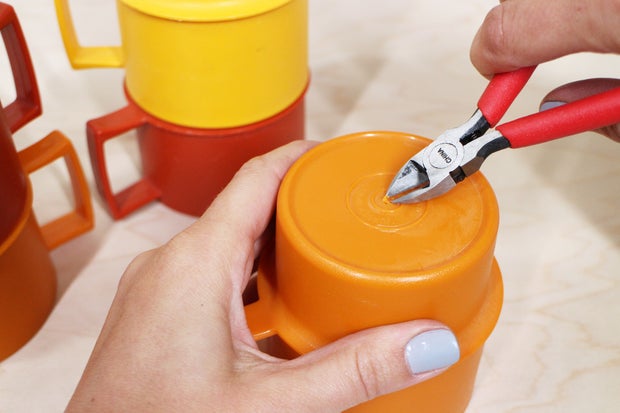
The way to solve this is to use the small wire cutters to snip them out. The plastic is surprising soft and easy to trim out. (This part's kinda satisfying.)
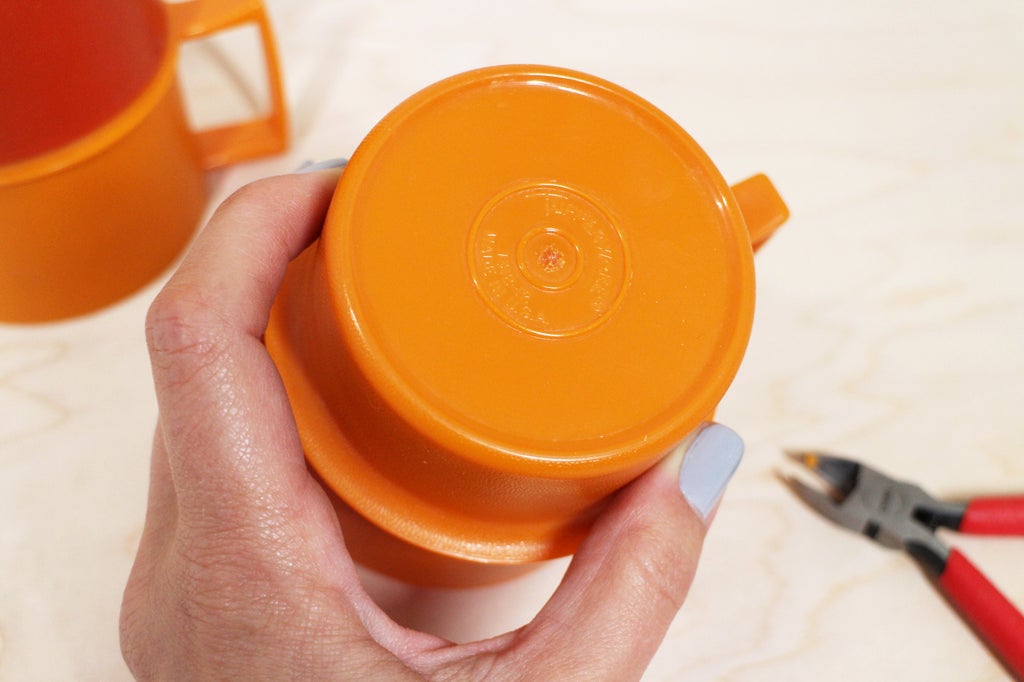
You'll end up with a little negative divot instead of a positive bump. This is what we want. Repeat this for the rest of the mugs.

Now, we're going to drill holes JUST bigger than the threaded rod. The 10mm step on the step bit is perfecto or 3/8" - 7/16" if you're using a standard bit.

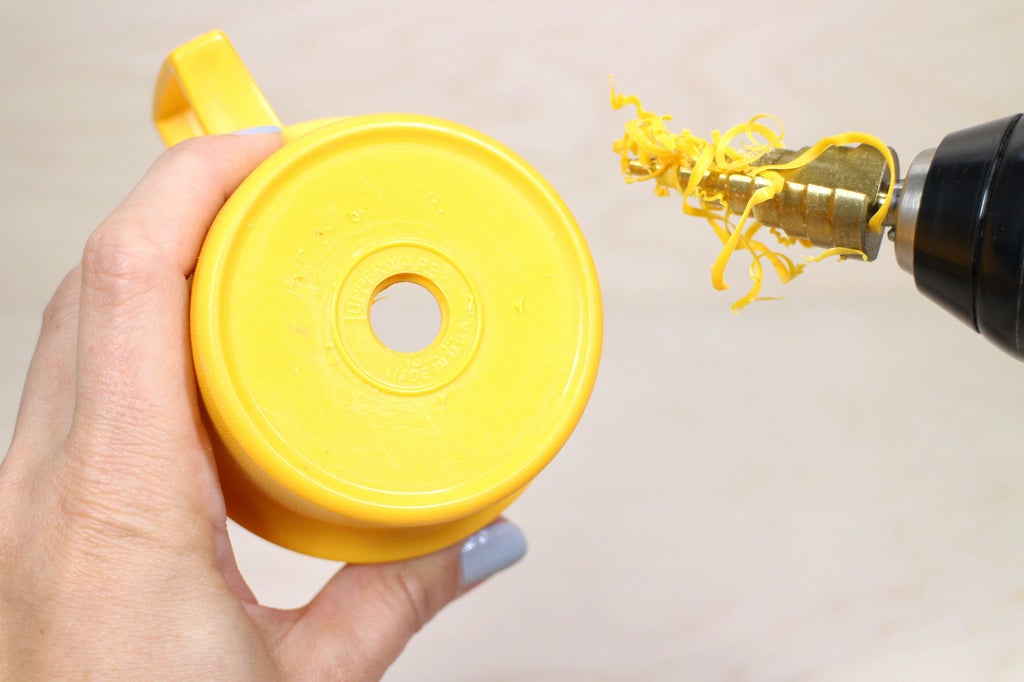
Place a cup upside down on the grip mat, press down firmly with your non-dominant hand, and drill! Repeat for the rest of the cups.

Step 13: Mug Stack Lamp: Part Assembly

Add the nut, lock washer, and reg. washer to one end of the threaded rod, like pictured above.

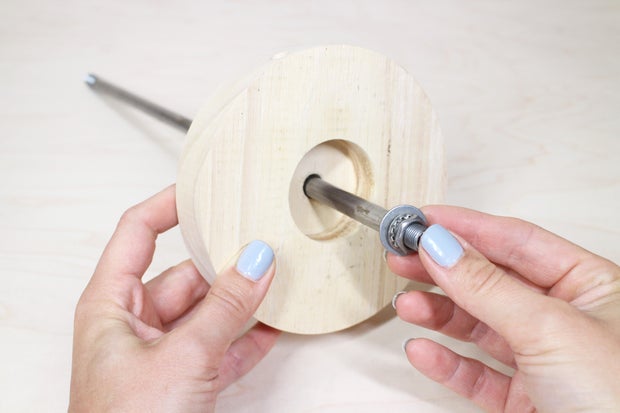
Stick the rod up through the bottom of base...

Until the hardware reaches the base. Place the base back on the table with rod sticking up. Set aside.
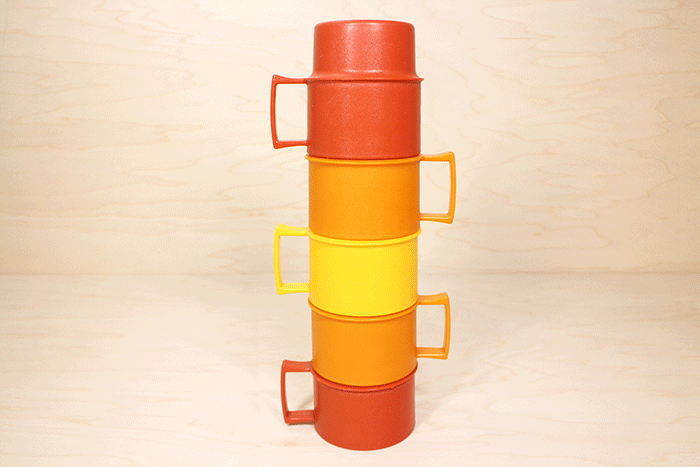
Now it's time to decide what order you want the colored mugs to be stacked in! Play around with different combinations until you landed on the one you love the most.

Then load the mugs onto the threaded rod in that order, topping the stack off with the metal neck.


On top of the neck, stack the harp saddle and a lock washer.

Add a knurl nut and hand tighten it.

Then lay the lamp down and hold onto the bottom nut while you hand tighten the top nut.


As you're tightening, make sure that the threaded rod coming out the bottom nut isn't sticking out so far that the cord will be pinched once the lamp is set upright. You want there to be at least 3/8" space between the rod bottom and the bottom of the wooden base.
At the same time, make sure that the rod coming out of the top knurl nut is enough/not too much for screwing on the socket cap. If you have to choose one to be longer, make it the top section, as we can just add another knurl nut if necessary to take up that extra space below the cap.
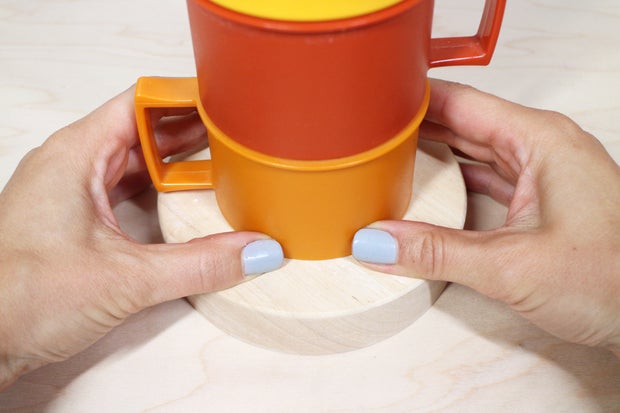
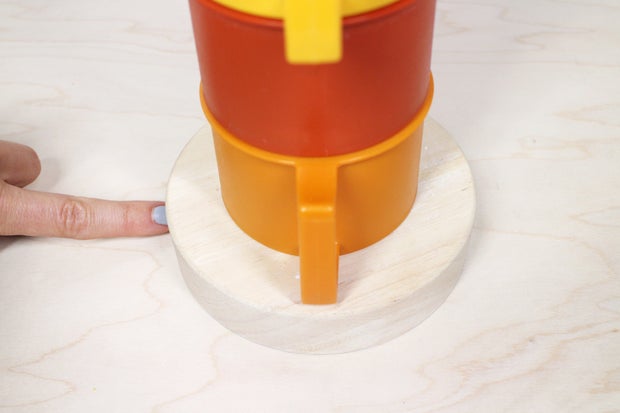
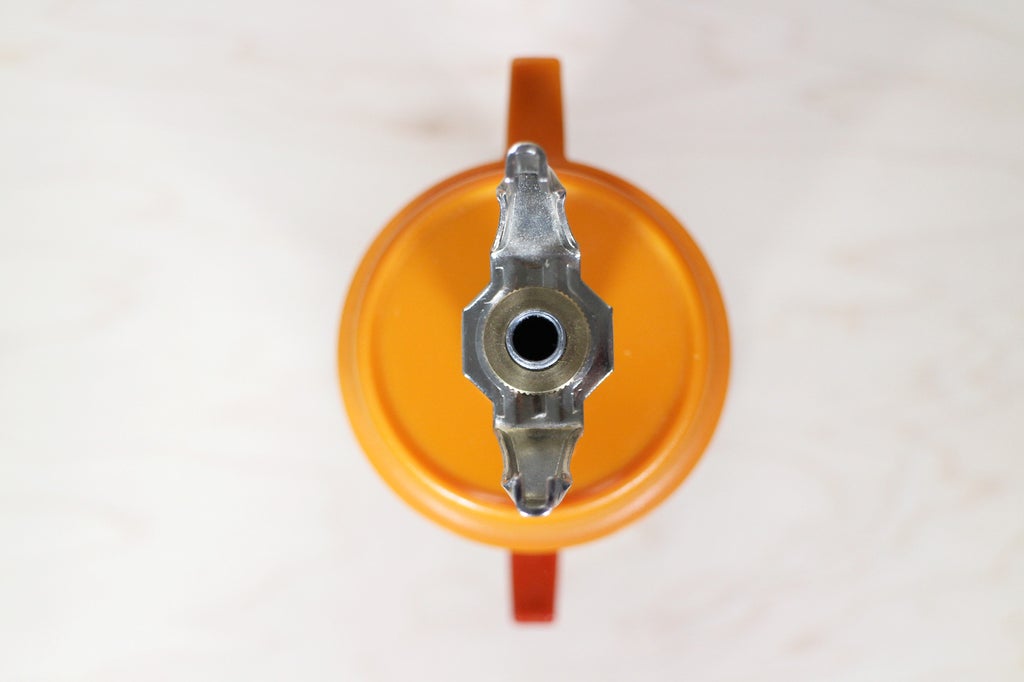
At this point, we want to set the lamp back up and make sure the cups, cup handles, neck, etc. are all lined up the way we want them before we use tools to tighten. Make sure to place the lamp base's hole out where you want it in relation to the cups.

Carefully lay the lamp back down. Grab the top knurl nut with the larger Channellock pliers in your non-dominant hand. Then give a final tightening to the bottom nut with the small pliers.


While you're down there, add the interior cord bushing to the rod end. This protects the cord from coming in contact with a sharp metal edge.

Now for the final hardware assembly step... screw on the socket cap and tighten the side screw.
Ta Da! Now it's time to wire it up.
Step 14: Mug Stack Lamp: Wire It Up!

Put one end of the lamp cord in through the side hole of the wooden base, and keeping a large loop, send the cord up the threaded rod and feed it up until it comes out the cap about 3".
While holding onto the top wire section, pull the excess bottom cord out through the base side so that the lamp can sit upright and flat.


Pull the two wires apart and tie an Underwriter's Knot. To learn how to do this, visit Lesson 3 of my Lamps Class.

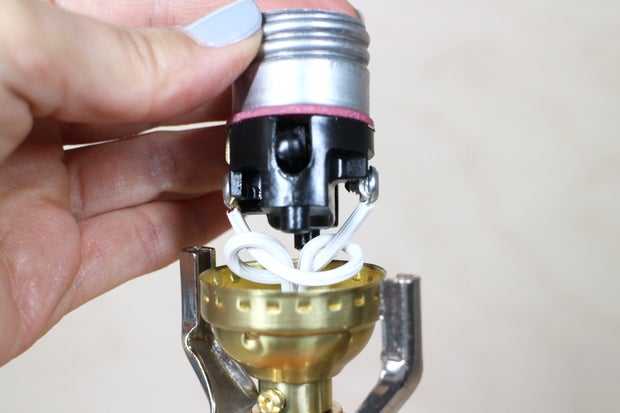
Strip 5/8" of insulation off the wires, then fan, twist, 'U' shape 'em, and wire up the socket! To learn how to safely wire the socket, read through Lesson 3 of my Lamps Class.

Slide the shell on and snap it into place.



Now it's time to add the plug. To see how to do it correctly, see Lesson 4 of my Lamps Class.

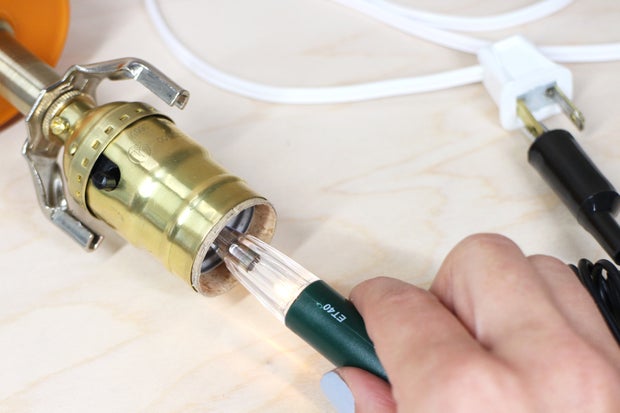
Now that you've put everything together, it's time to test your work. Use a continuity tester or multimeter to test your connections. Because safety is awesome!!
Now we're going to add some felt to the bottom to ensure it's as smooth as butter for all your surfaces.
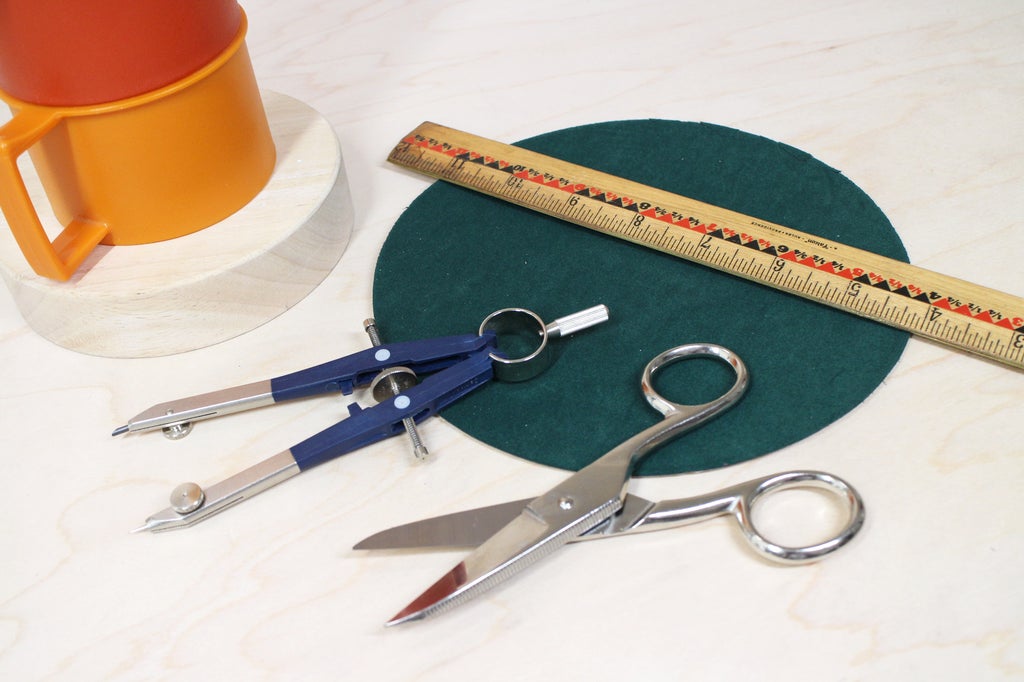
If you read through the Thermos Lamp instructions, you may have noticed that I attached the felt and THEN cut off the excess. Because this is a lighter colored base, I want to ensure that the dark colored felt isn't seen at all. To do this, we're going to cut a felt circle that is slightly smaller than the diameter of the base and then attach it.
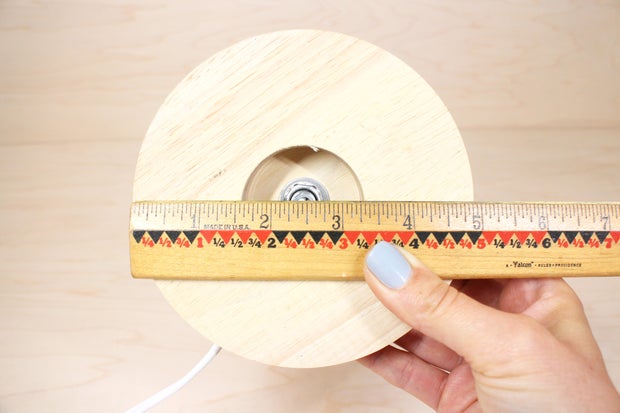

To do this, measure the diameter of the base and set the compass so that it's slightly less than half the diameter (= radius).



Draw the circle on the back of the felt piece and cut it out.


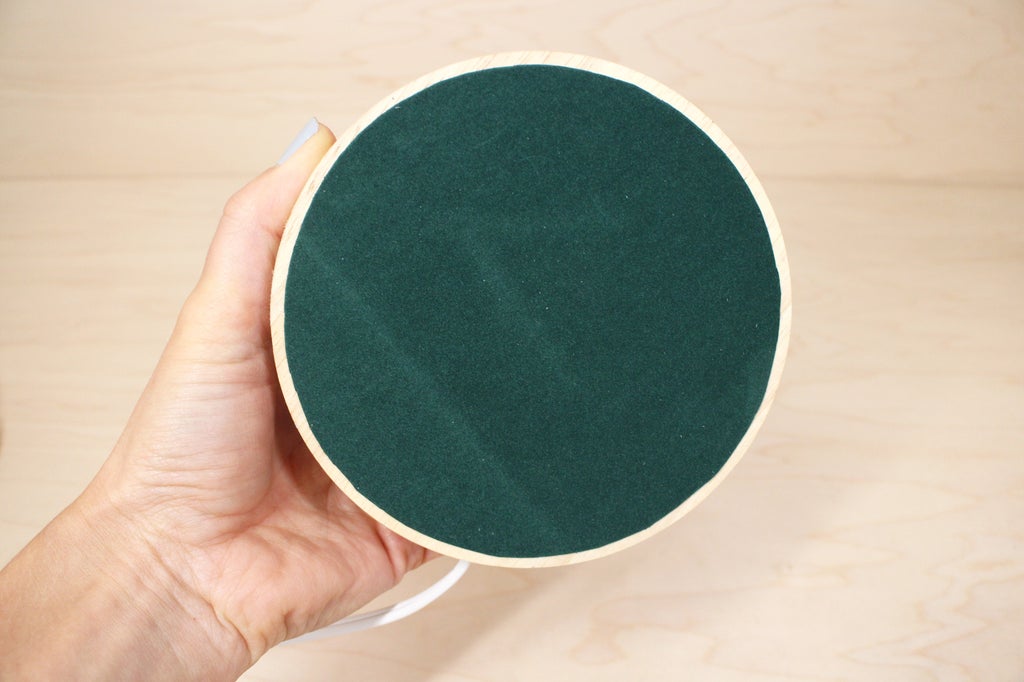
Remove the backing and center it on the base, rubbing and smoothing it onto the wood.

And there you have it, super stealth felt.
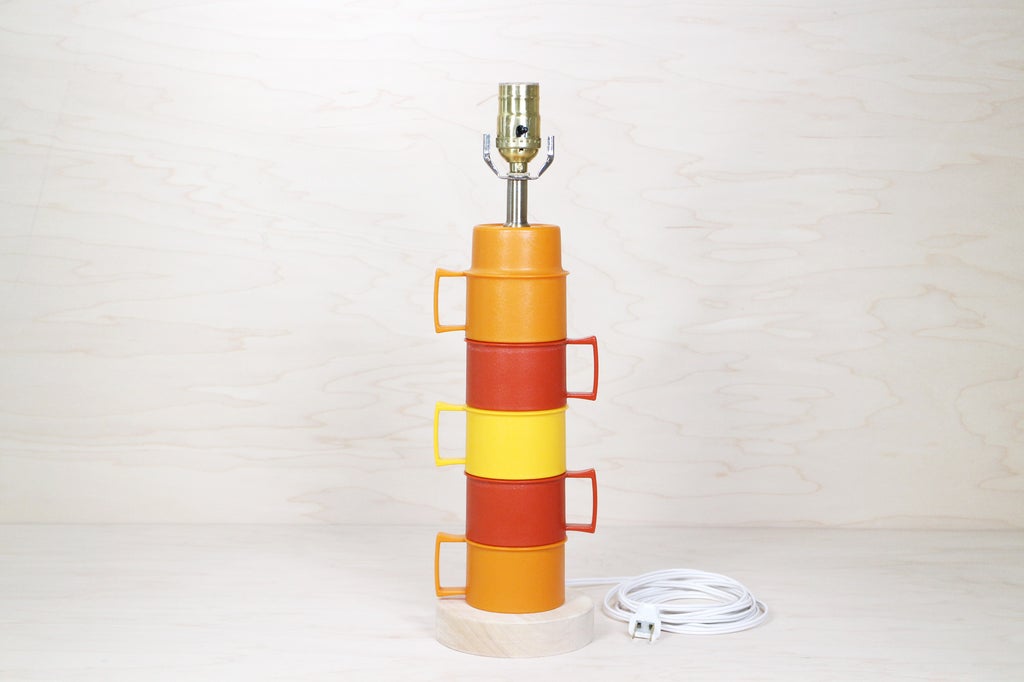
Now you've done it. Look at that...GORGEOUS!
Step 15: That a Wrap!
If you enjoyed learning about lighting, you may also be interested in my other lamp instructables:
Happy Making!




